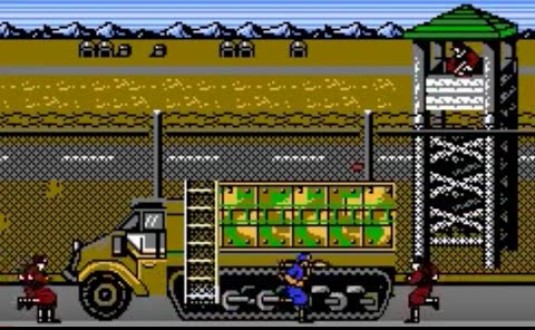
In the mid-1980s the Cold War inspired militaristic movies, kids' TV programming, science fictions (militaristic and oppositional), and video games. Indeed, Konami eyed Western markets with a money-making glint in their eye and rode the wave with a clutch of military-themed games: Jackal, Combat School/Boot Camp, and Contra (a bit dodge that one, naming a shooter after Nicaraguan death squads). Green Beret was the first of this wave of titles, with it renamed Rush'n Attack for the unsubtle alliteration.
As per military-themed games before and since, the (80s) mediascape full of one-man-army scenarios is the necessary context. A bunch of forces personnel are held prisoner by the dastardly Soviets and they're going to get shot unless they're liberated by a hardy commando. In the arcade game, your protagonist walks from left to right armed with nothing but a knife to stab away the evil communists as they bear down on you. Your antagonists come in three flavours. The bog-standard henchman who simply runs at you and does nothing. Then we have the martial artists who take to the air with a flying kick when they venture near. There is the gunman - you'll never guess what he does. We also have guest appearance from parachutists, dogs, and gentlemen dropping bombs from microlight aircraft. Then there's the power up guy. Stick him with the blade and he drops a weapon. It can be a flame thrower, a bazooka, or a grenade depending on the level. Get to the end and the customary boss awaits. Except it doesn't. Instead, a full-on phalanx of bad 'uns come at you. They're very easy to dispatch if you still have the secondary weapon. If not, fancy knife work is your only way out of the pickle.
NES Rush'n Attack changes this up for the better. For one, the game is longer than the arcade and home ports as Konami added two extra levels. And you should think so too considering how much more expensive it was compared to the others. The music here is better and accompanies the game without wanting to turn the speaker off. The plot has also been changed and alterations made to the power ups. Now, instead of rescuing wayward GIs the name of the game is destroying a missile the Sovs want to launch at the Home of the Brave. And along the way, one can acquire a gun (for a time limited interval) to blow all them commies away. And, it seems, the bazooka and grenades are more plentiful. But, sadly, not the flame thrower. You can have a video game glorifying American militarism, one that sees the protagonist stab hundreds of people to death during the course of a play through, but turning them into pixelated flaming skeletons was a step too far for Nintendo's censorious instincts.
The gameplay, however, is entirely the same as its arcade parent. Except there's more of it. Rush'n Attack involves a bit of memorisation, but not heavy on learning the patterns, except for the end-level confrontations. The enemies come thick and fast, but never to the point of being overwhelmed. There's always a way through. Occasionally, a flying kick soldier will be spawned with a grunt and they'll come at you from the same side at once. Jumping to take out the Jackie Chan wannabe risks falling on the other and dying an inglorious death. Another annoying bug, present in all versions, is jumping and getting caught on a ladder. It means dealing with your high kicking foes has to be timed and take place away from the steps. What is properly irksome is the decision to use up on the direction pad as jump, when the NES convention of using a button was already established by the time of release. It can lead to screw ups because making your dude jump accidentally is an ever present risk, and it happened to me all too many times. But this was the 80s, and little quirks of this character were ten a penny in games. They helped add to the challenge, and they didn't usually attract complaints from computer mag. That's how much they were part of convention.
There are a couple of messages we can take from Rush'n Attack. Overt is the might-is-right nonsense. Getting to the end of the game, taking out the waves of baddies, nicking their bazookas and blowing up the naughty rocket, we are treated to a brief, rudimentary sequence in which the base explodes and our hero flees the scene, underneath the legend "You have saved the world! Congratulations! Peace has arrived at last!". Fighting for peace, you've got to love it. The second is much more subtle, and is about weakness. Admittedly, Rush'n Attack wouldn't be much cop if our green beret (who, by the way, wears a blue beret throughout) was well 'ard and could soak up punishment like a sponge, as per other military titles. The one hit death makes for quite a challenging title for the uninitiated. But doesn't this also say something about the jitters underpinning the 80s Cold War mentality? Here we have a special forces soldier who can be slain by the mere touch of an enemy. For all the advantages the player character has over its computer-controlled opponents: occasional ranged weapons, a knife with decent reach, the ability to learn and apply tactics, no matter how prepped and tooled up our character is, just like Uncle Sam he is fragile and vulnerable and can fail at any moment. And so, a Japanese video game developer watching Hollywood from afar was able to encode the bravado and anxiety of Reagan's America into the game mechanics of an enjoyable and otherwise brainless militaristic slash-a-thon.
No comments:
Post a Comment